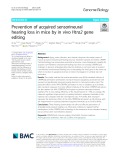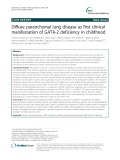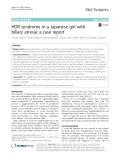
Sensorineural deafness
-
Aging, noise, infection, and ototoxic drugs are the major causes of human acquired sensorineural hearing loss, but treatment options are limited. CRISPR/ Cas9 technology has tremendous potential to become a new therapeutic modality for acquired non-inherited sensorineural hearing loss.
 23p
23p  viarchimedes
viarchimedes
 26-01-2022
26-01-2022
 11
11
 0
0
 Download
Download
-
GATA-2 transcription factor deficiency has recently been described in patients with a propensity towards myeloid malignancy associated with other highly variable phenotypic features: chronic leukocytopenias (dendritic cell-, monocyto-, granulocyto-, lymphocytopenia), increased susceptibility to infections, lymphatic vasculature abnormalities, and sensorineural deafness.
 7p
7p  vimontana2711
vimontana2711
 05-04-2021
05-04-2021
 9
9
 2
2
 Download
Download
-
Hypoparathyroidism, sensorineural deafness, and renal dysplasia (HDR) syndrome is an autosomal dominant disorder. We report the first detailed case of hypoparathyroidism complicated by biliary atresia.
 4p
4p  vichengna2711
vichengna2711
 25-02-2020
25-02-2020
 15
15
 1
1
 Download
Download
-
Thiamine-responsive megaloblastic anemia (TRMA) is a rare autosomal recessive inherited disease characterized by the clinical triad of megaloblastic anemia, sensorineural deafness, and diabetes mellitus. To date, only 100 cases of TRMA have been reported in the world.
 6p
6p  virome2711
virome2711
 13-01-2020
13-01-2020
 10
10
 0
0
 Download
Download
-
Also lentigines. b Polyostotic fibrous dysplasia. c See also "Papulonodular Skin Lesions." d Late 1980s. A proliferation of melanocytes results in the following pigmented lesions: lentigo, melanocytic nevus, and melanoma (Chap. 83). In an adult, the majority of lentigines are related to sun exposure, which explains their distribution.
 5p
5p  konheokonmummim
konheokonmummim
 30-11-2010
30-11-2010
 82
82
 5
5
 Download
Download
-
Approach to the Patient: Disorders of the Sense of Hearing The goal in the evaluation of a patient with auditory complaints is to determine (1) the nature of the hearing impairment (conductive vs. sensorineural vs. mixed), (2) the severity of the impairment (mild, moderate, severe, profound), (3) the anatomy of the impairment (external ear, middle ear, inner ear, or central auditory pathway), and (4) the etiology. The history should elicit characteristics of the hearing loss, including the duration of deafness, unilateral vs. bilateral involvement, nature of onset (sudden vs.
 5p
5p  ongxaemnumber1
ongxaemnumber1
 29-11-2010
29-11-2010
 80
80
 4
4
 Download
Download
CHỦ ĐỀ BẠN MUỐN TÌM


















